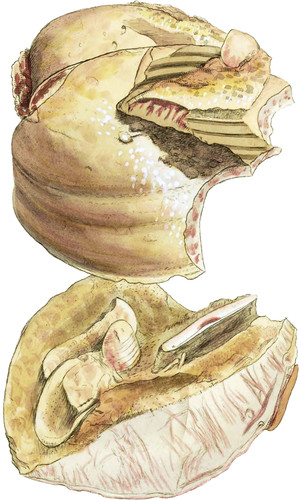 Enlarge
Enlarge
British Mineralogy
- Div. 2. Imitative.
This might be called a Jaspcrine or Porcelain flint, and is extremely curious, as having taken place of a shell much resembling Venus Islandica, and seems merely to differ in being deeper. This appearance is rarely found, especially in the place, as it were, of the shells themselves.
The top figure shows fragments of an Escallop, looking like recent ones, but are of a most compact Silex, semi-transparent like the natural shell.
The lower figure shows a transverse piece, separated at the crack, with somewhat dendtritical veins, giving the appearance of China. It has also the cast of other shells that were involved in the same catastrophe. The Rev. Dr. Beeke was so good as to favour us with this curious specimen, which was found at Little Teignmouth in Devonshire; and the Rev. Dr. Sutton has favoured me with a shell, probably of the same species, from Elmsett in Suffolk, but little changed, being nearly like such as may be found exposed, and dead, on the coast. It has some fragments of Sertularia with Lime and Gravel about it. I have some of the same, which I found at Sydenham when the canal was digging there in the year 1 805, in a marly Septarium. So we may trace the same shell at very different places; which wilt not only be a help in geology, but will show at one view the varieties to which Flint is liable, and not only that it may be capable of taking casts or impressions, but be in different states during that operation. In this instance it seems to have been considerably diluted, as the dendrites (if I may so call the red lines) are much attenuated.

